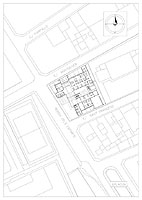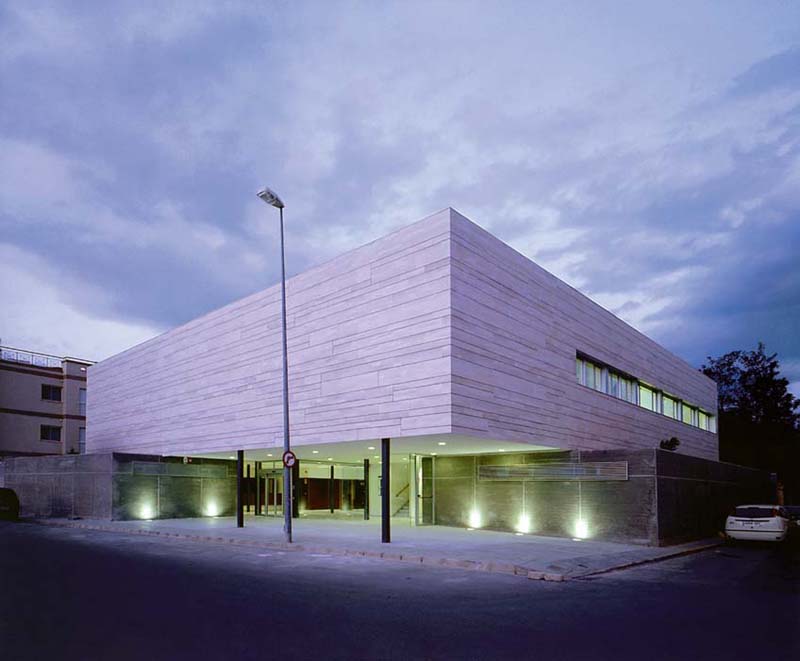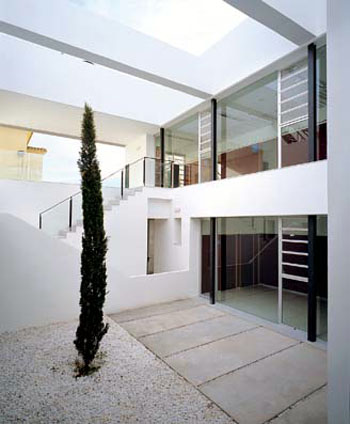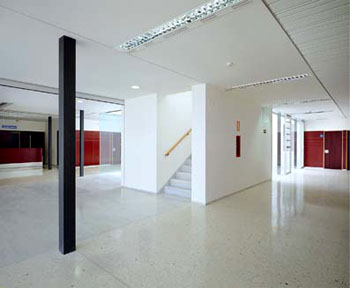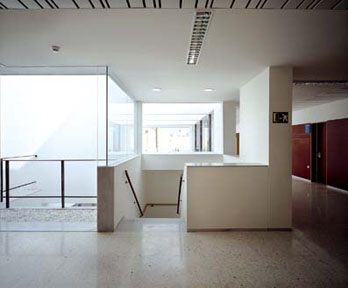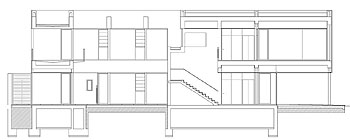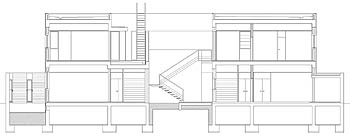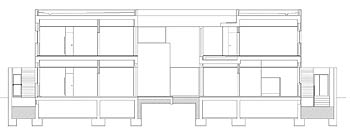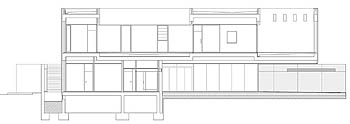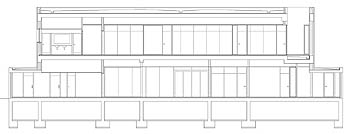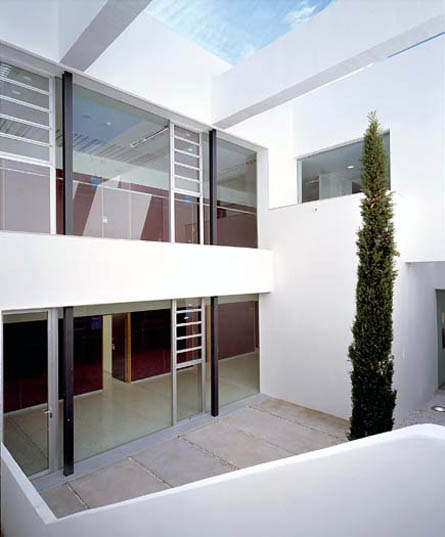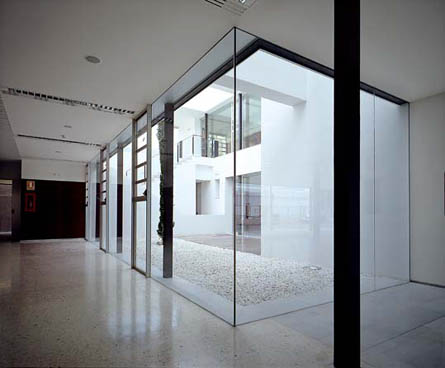| En el
casco urbano, junto a la Ronda del´s Esports, se encuentra el edificio.
En el punto de encuentro de dos escalas, la más doméstica de las
viviendas unifamiliares con calles que no sobrepasan los 8.00m. de
anchura, en las fachadas Norte y Sur, y la escala mayor de los
equipamientos en la Ronda también de mayor sección, en la fachada
orientada a poniente. El centro de Salud comparte la manzana con el
edificio de las antiguas escuelas que evidencia su carácter de edificio público
al ser la única edificación abierta en esta parte del casco urbano. El
resto son viviendas unifamiliares entre medianeras.
La necesidad de resguardar los
espacios interiores de la mirada de los edificios vecinos y de procurar la
escala necesaria al edificio, determina la elección de un volumen
sencillo sobre el que se perforan vacíos para obtener la luz necesaria,
con un objetivo prioritario en la composición: “ver entrar” la luz en
el edificio.
El acceso se sitúa en un espacio
cubierto identificable con facilidad tanto desde la Ronda como desde la
C/Sant Françesc, la de mayor continuidad en dirección al centro del
casco urbano. En planta baja se sitúan las áreas de Recepción, control
y archivo, urgencias, extracciones periféricas, pediatría, un almacén y
los servicios generales. Se ha cuidado especialmente la posibilidad de
tener el área de urgencias en servicio, vinculada a la de extracciones y
al control y archivo de historias clínicas pudiendo mantener el resto del
centro cerrado. En planta primera se sitúan las áreas de Medicina
General y Maternal, así como el área administrativa, con la privacidad
que requiere.
El edificio se resuelve en dos
plantas, con las entradas de luz creadas de manera que se salvaguarda la
privacidad de los espacios, pero también la adecuada relación entre áreas.
Los materiales ayudan a
identificar la composición, los muros de hormigón gris cierran los
patios y los espacios de planta baja, fuera de la geometría impuesta al
volumen de la primera piedra, resuelto con un aplacado de piedra moka
portuguesa, con un despiece a la romana y juntas destacadas sólo en la
esquina sobre el acceso principal.
En el interior, la estructura metálica
pasa desapercibida entre tabiques de cartón yeso revestidos hasta la
altura de las puertas con paneles acabados en madera en las zonas comunes.
Los cierres al patio se resuelven acristalados, diseñando las particiones
de carpintería para minimizar la presencia del aluminio, dejando el
vidrio como verdadero elemento de cierre o de conexión,
interior-exterior.
Centrado en el conjunto de la
parcela en un lugar alejado de las vistas desde la calle, se situa un
local en planta baja y un espacio en cubierta para ubicar la maquinaria de
las instalaciones, con la posibilidad de acceder directamente desde este
lugar a las dos partes principales que componen el edificio: el ala Norte,
con urgencias, extracciones, administración y maternidad, y el ala Sur,
con pediatría y medicina general.
|
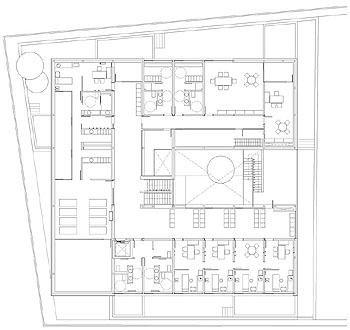
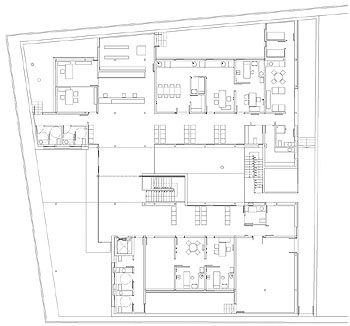
|
|
The building is in the urban nucleus, on the
Ronda dels Esports. It stands at the meeting point between two scales, the
more domestic one of single-family housing in streets that are no more than
8 m wide on its north and south sides and the larger scale and section of
the community services buildings on the Ronda, on its west-facing side. The
health centre shares a street block with a former school, which shows its
public nature by being the only free-standing building in this part of the
urban area. The rest are terraced houses.
The need to protect the interior spaces from
the eyes of the neighbouring buildings and give the building the necessary
scale led to the choice of a simple volume pierced by voids to obtain the
necessary light, with a priority objective in its composition being to
“see light enter”.
The entrance is placed in a covered space
that is easily identifiable from both the Ronda and Calle Sant Francesc, the
longer of the streets leading towards the town centre. The ground floor has
the reception area, supervision and filing, emergencies and sample
extraction areas, pediatrics, a store room and general services. Particular
care was taken to make it possible to keep the emergencies area in service,
linked to the extractions and medical records supervision and filing areas,
while the rest of the health centre is closed. The first floor holds the
General Practice and Maternity areas, as well as the administration area,
with the privacy it requires.
The building is laid out on two floors,
creating entrances for the light in a way that safeguards both the privacy
of each space and an appropriate relationship between the areas.
The materials help to identify the
composition. The grey concrete walls close the spaces and courtyards on the
ground floor, outside the shape imposed on the volume of the first floor,
which has a Portuguese moka stone facing in ‘Roman style’ formats with
the joints emphasised only at the corner over the main entrance.
In the interior, the metal structure passes
unnoticed among the plasterboard partitions clad to door height in
wood-finish panels in the shared areas. The courtyard is walled with glass
and the joinery partitions are designed to minimise the presence of the
aluminium, leaving the glazing as the true interior/exterior
closing/connecting element.
Centred in the plot as a whole, set apart from
the views from the street, a room has been placed on the ground floor and a
space on the roof for the machinery associated with the installations, with
the possibility of direct access from there to the two main parts of the
building: the north wing, with emergencies, sample extraction,
administration and maternity, and the south wing, with pediatrics and
general practice.
|
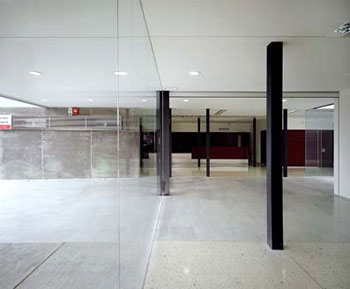
|
